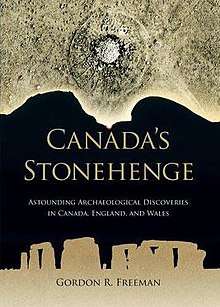Canada's Stonehenge
 Cover | |
| Author | Gordon Freeman |
|---|---|
| Country | Canada |
| Language | English |
| Subject | Majorville Cairn and Medicine Wheel site |
| Published | 2009 (Kingsley Publishing) |
| Media type | |
| Pages | 312 |
| ISBN | 978-0978452612 |
Canada's Stonehenge: Astounding Archaeological Discoveries in Canada, England, and Wales is a 2009 self-published[1] book by chemistry professor Gordon Freeman,[2] in which the author claims that the Majorville Cairn and Medicine Wheel site, located south of Bassano, Alberta is actually a precise 5,000-year-old calendar. He also discusses Stonehenge, which he believes was also a calendar.
Sun Temple
This structure is known by archaeologists as a medicine wheel dated to 3200 BCE (5200 years ago) by careful stratification of known artifact types.[3][4] Medicine wheels are constructed by laying stones in a particular pattern on the ground oriented to the four directions. Most medicine wheels follow the basic pattern of having a center of stone, and surrounding that is an outer ring of stones with "spokes" (lines of rocks) radiating from the center to the cardinal directions (East, South, West and North).medicine wheels are sited throughout the northern United States and southern Canada, specifically South Dakota, Wyoming, Montana, Alberta and Saskatchewan.
Gordon Freeman challenges their assumption in his book, stating that it is actually a 26 square-kilometer stone calendar that marks the changing seasons better than our modern calendar. Freeman believed that those rocks and rock piles were "highly engineered," and could not be natural. He spent 28 years photographing the site at different times of year and looking for astronomical alignments.[5] He was able to discover that the 28 rays that radiate from the central cairn correspond exactly to the length of a lunar cycle. This assured Freeman that the rocks are not just randomly distributed but were actually precisely placed there for a reason.[6] It has been noted, however, that the author engages in "speculation that treads close to fiction", often using conditional phrases "such as perhaps, presumably, seems to be, and might have been".[1]
Unlike Stonehenge which is megalithic, or constructed of extremely large rocks, the Majorville site is constructed of small piles of rocks (cairns) which Freeman says are patterned over an extremely large area. He describes it as a complex, spider-web‐like pattern of stones extending over an area of about thirty square kilometres. He views the hilltop centrepiece of the site as a sunburst image made of stones.[2]
Freeman believed that those rocks and rock piles were "highly engineered," and could not be natural. He spent 28 years photographing the site at different times of year and looking for astronomical alignments.[5]
Freeman argues that the 28 rays of the medicine wheel show that it is a lunar calendar.[5]
University of Alberta archaeologist Jack Ives is cautious about accepting Freeman's ideas. He notes that as the area is an ancient glacial moraine "[y]ou have to be very careful about what you line up". However, he did agree that the radial lines "may certainly reflect solstices and equinoxes. How much more sophisticated beyond that has been a subject of debate".[7]
References
- 1 2 Yellowhorn, Eldon (2010), "Review of Canada's Stonehenge: Astounding Archaeological Discoveries in Canada, England, and Wales", Canadian Journal of Archaeology / Journal Canadien d'Archéologie, 34 (1): 128–130, JSTOR 41103691
- ↑ The Majorville Cairn and Medicine Wheel Site, James M Calder, National Museum of Man Series, Archaeology Survey of Canada No. 62, Ottawa, 1977
- ↑ "Medicine Wheel National Historic Landmark". Archived from the original on 2008-01-25. Retrieved 2008-01-05.
- 1 2 3 Weber, Bob (2009-01-29). "An academic maverick is challenging conventional wisdom on Canada's prehistory by claiming an archeological site in southern Alberta is really a vast, open-air sun temple with a precise 5,000-year-old calendar predating England's Stonehenge and Egypt's pyramids". The Toronto Star. ISSN 0319-0781. Retrieved 2016-03-12.
- ↑ "About the Book". Canada's Stonehenge. 2013. Archived from the original on 26 April 2013. Retrieved 11 June 2013.
- ↑ https://www.thestar.com/news/canada/2009/01/29/alberta_sun_temple_has_5000yearold_calendar.html
External links
- Article in The Globe and Mail
- Official Website
- Web page of Gordon Freeman at University of Alberta
- http://hiddenstonehenge.com/